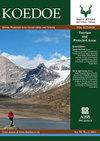Waterbird community changes in the Wilderness Lakes, South Africa (Part 3 of 3): Diving piscivores and scavengers
IF 1.1
4区 环境科学与生态学
Q3 BIODIVERSITY CONSERVATION
引用次数: 0
Abstract
Estuarine waterbodies typically support diverse and abundant waterbird communities. However, global environmental degradation as a result of anthropogenic activities is leading to species level changes in biodiversity, with top predators such as piscivorous waterbirds being particularly vulnerable to ecosystem changes. The study aimed to document long-term spatial and temporal patterns of abundance of piscivorous and scavenging waterbirds in the Wilderness Lakes Complex (WLC) in the Garden Route National Park, South Africa, and where possible identify potential causes for observed trends. The abundance of waterbirds on these wetlands was determined biannually from 1992 to 2019, with counts conducted from a boat following a standardised route. Historical waterbird abundance data from the 1980s were also used to describe long-term abundance changes. Eight of the species exhibited seasonal variability in abundance with most, excluding Common Tern Sterna hirundo, being more abundant in winter. Substantial changes occurred in the abundance of several species over the four-decade study period, notably increases in Cape Cormorant Phalacrocorax capensis and Great Crested Grebe Podiceps cristatus, and decreases in Common Tern and Black-necked Grebe Podiceps nigricollis. Long-term abundance trends indicate a combination of declining, increasing, and stable populations. Although some species have undergone contrasting abundance changes on different waterbodies in the WLC the dominant pattern was a similar direction of change on most or all waterbodies and in different seasons. Local reasons for changes probably include loss of sandbanks, changing prey availability, and the absence of recreational disturbance on some waterbodies.Conservation implications: Drivers of changes in the abundances of piscivores are likely to be multifaceted, functioning on multiple spatial and temporal scales, and affecting different species in different ways. Recommended local corrective actions include managing emergent macrophyte encroachment on sandbanks, reducing recreational disturbance, managing processes affecting indigenous fish stocks, and protecting nesting sites.南非荒野湖泊的水鸟群落变化(第三部分,共 3 页):潜水食鱼鸟和食腐鸟
河口水体通常支持多样化和丰富的水鸟群落。然而,人类活动导致的全球环境退化正在导致物种层面的生物多样性变化,其中顶级捕食者,如食鱼水鸟,特别容易受到生态系统变化的影响。该研究旨在记录南非花园路线国家公园的荒野湖泊复群(WLC)中食鱼和食腐水鸟数量的长期时空格局,并在可能的情况下确定观察趋势的潜在原因。从1992年到2019年,每两年对这些湿地上水鸟的丰度进行一次测定,并沿着标准化路线从船上进行计数。20世纪80年代水鸟数量的历史数据也被用来描述长期的数量变化。其中8种的丰度呈季节性变化,除普通燕鸥外,大多数在冬季丰度较高。在40年的研究期间,一些物种的丰度发生了实质性的变化,特别是角鸬鹚(Phalacrocorax capensis)和大冠Grebe Podiceps cristatus增加,而普通燕鸥和黑颈grebe Podiceps nigricollis减少。长期丰度趋势表明种群数量的下降、增加和稳定。虽然某些物种在不同水体上的丰度变化存在差异,但在大部分或所有水体和不同季节中,丰度变化的主导格局是相似的。变化的局部原因可能包括沙洲的消失,猎物的可用性变化,以及一些水体缺乏娱乐干扰。保护意义:鱼类丰度变化的驱动因素可能是多方面的,在多个时空尺度上发挥作用,并以不同的方式影响不同的物种。建议的地方纠正措施包括管理对沙洲的紧急大型植物侵占,减少娱乐干扰,管理影响本地鱼类资源的过程,以及保护筑巢地点。
本文章由计算机程序翻译,如有差异,请以英文原文为准。
求助全文
约1分钟内获得全文
求助全文
来源期刊

Koedoe
BIODIVERSITY CONSERVATION-
CiteScore
3.30
自引率
0.00%
发文量
10
审稿时长
20 weeks
期刊介绍:
Koedoe, with the subtitle ''African Protected Area Conservation and Science'', promotes and contributes to the scientific (biological) and environmental (ecological and biodiversity) conservation practices of Africa by defining the key disciplines that will ensure the existence of a wide variety of plant and animal species in their natural environments (biological diversity) in Africa.
 求助内容:
求助内容: 应助结果提醒方式:
应助结果提醒方式:


